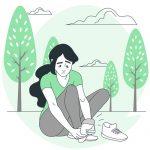
Stretch Marks are a common and unsightly skin condition that can appear on any part of the body. They typically appear as pink, purple, or red streaks on the skin that can sometimes look like scarring. If you do develop stretch marks, remember that they are a completely normal part of the body’s natural process and do not need to be a source of shame or embarrassment. Although stretch marks can affect anyone, they are most common in pregnant women, teenagers, and people who have recently gained or lost a significant amount of weight. Stretch marks can be a source of concern and can affect a person’s self-esteem, especially if they are in visible areas. In this blog post, we will discuss the various causes of stretch marks, treatments that can be used to reduce their appearance, and ways to prevent them from occurring in the first place.
What are stretch marks?
Stretch marks, also known as striae, are lines or streaks that develop on the skin’s surface. They typically appear as long, narrow stripes that are reddish or purplish at first, but eventually fade to a lighter color. Stretch marks often occur on areas of the body where the skin has been stretched or expanded rapidly, such as during pregnancy, puberty, or rapid weight gain. They can appear on various body parts, including the abdomen, thighs, hips, breasts, and upper arms. Stretch marks are common among both men and women, but are more prevalent in women. While stretch marks are not harmful or medically concerning, they can be a cosmetic concern for some people.
What causes stretch marks?
Stretch marks can occur when your skin undergoes rapid stretching, causing the underlying tissues to stretch beyond their normal limits. This results in the development of thin, long, and jagged scars known as stretch marks.
There are several factors that contribute to the development of stretch marks, including:
1. Rapid weight gain or loss
When the body gains weight rapidly, the skin is stretched beyond its normal limits, causing stretch marks. This is because the skin has limited elasticity and can only stretch so much before it starts to tear, leaving behind stretch marks. Similarly, when the body loses weight quickly, the skin may not be able to keep up with the pace of the weight loss, leading to stretch marks. This is why people who undergo bariatric surgery, for example, are at higher risk of developing stretch marks. The sudden changes in weight put a lot of stress on the skin, leading to the development of stretch marks.
2. Pregnancy
Pregnancy is one of the most prevalent causes of stretch marks. And here comes the annoying question. Why do women get stretch marks after giving birth? The answer is as follows: During pregnancy, the skin stretches to accommodate the growing fetus, causing stretch marks on the abdomen, thighs, and breasts. This is because the skin is stretched beyond its normal limits to make room for the growing baby. Hormonal changes during pregnancy can also weaken the skin’s elasticity, making it more susceptible to stretch marks. As the skin is stretched during pregnancy, the collagen and elastin fibers in the skin are pulled apart, leading to the development of stretch marks.
3. Puberty
Adolescents going through puberty experience rapid growth spurts that cause the skin to stretch, leading to the appearance of stretch marks. This is because the body is growing quickly during this time, and the skin is not able to keep up with the growth rate. As a result, the skin is stretched beyond its normal limits, leading to the development of stretch marks. These marks are often seen on the thighs, hips, and breasts.
4. Genetics
Some people are more prone to developing stretch marks than others due to genetic factors. If your family members have stretch marks, you may be more likely to develop them too. This is because certain genetic factors can affect the skin’s ability to produce collagen and elastin, which are essential for maintaining the skin’s elasticity. People with certain skin types, such as those with lighter skin, may also be more prone to developing stretch marks.
5. Bodybuilding
Bodybuilding is a common cause of stretch marks, particularly in men. When individuals engage in weight training to build muscle mass, they may experience rapid muscle growth and weight gain. This rapid increase in muscle size and weight can cause the skin to stretch beyond its limits, leading to the development of stretch marks.
Bodybuilding-related stretch marks are often seen in the areas of the body that are most affected by weight training, including the shoulders, biceps, chest, and thighs. These areas of the body are where the muscle mass is concentrated, and the skin may not be able to keep up with the rapid growth of the muscles.
6. Medical conditions
Certain medical conditions such as Cushing’s syndrome, Marfan syndrome, and Ehlers-Danlos syndrome can increase the risk of developing stretch marks. These conditions affect the body’s ability to produce collagen, which is essential for maintaining the skin’s elasticity. In people with these conditions, the skin is less able to stretch and may tear more easily, leading to the development of stretch marks. Additionally, certain medications, such as corticosteroids, can also increase the risk of developing stretch marks.
7. Corticosteroid Medications
Corticosteroid medications, also known as steroids, are synthetic drugs that mimic the effects of hormones produced by the adrenal glands. They are often prescribed to reduce inflammation and swelling in various conditions, such as asthma, allergies, arthritis, and skin conditions like eczema and psoriasis.
While corticosteroids can be highly effective in managing these conditions, they can also have negative side effects, including the development of stretch marks. Corticosteroids work by suppressing the immune system, which can lead to a decrease in collagen production, making the skin more susceptible to tearing and the development of stretch marks.
Understanding the causes of stretch marks is important in determining the most appropriate treatment options. In the next section, we will discuss various treatment options for stretch marks.
How can I get rid of stretch marks?
Stretch marks can be frustrating to deal with, but the good news is that there are several treatment options available. Here is a list of some of the most effective treatments for stretch marks:
1. Topical creams and lotions
Stretch marks can be eliminated using over-the-counter creams and lotions containing ingredients such as retinoids, hyaluronic acid, and vitamin C. These products serve by increasing collagen production and suppleness of the skin. It’s important to bear in mind that topical treatments might take many weeks or months to show effective results.
2. Laser therapy
Laser therapy is a non-invasive procedure that uses high-energy light to break down the stretch marks, which are then absorbed by the body’s natural healing processes. This treatment can be effective for reducing the appearance of both red and white stretch marks. However, multiple sessions may be required to achieve optimal results.
3. Microdermabrasion
Microdermabrasion is a non-invasive procedure that uses a device to exfoliate the outer layer of skin. This treatment can help to reduce the appearance of stretch marks and improve skin texture. Microdermabrasion can be effective for treating mild to moderate stretch marks. However, it may not be as effective for deeper, more severe stretch marks.
4. Chemical peels
Chemical peels involve applying a chemical solution to the skin, which causes the outer layer of skin to peel off, revealing new, healthier skin underneath. This treatment can be effective for reducing the appearance of stretch marks. However, it can also cause redness and peeling, and it may not be suitable for people with sensitive skin.
5. Surgical procedures
In severe cases, surgical procedures such as abdominoplasty (tummy tuck) or brachioplasty (arm lift) may be necessary to remove excess skin and improve the appearance of stretch marks. These procedures are typically reserved for people with significant amounts of loose, sagging skin.
6. Retinoids
Retinoids are a type of vitamin A that are commonly used in skincare products to promote collagen production and improve skin texture. Retinoids have been shown to be effective in reducing the appearance of stretch marks.
It’s important to note that while these treatments can be effective in reducing the appearance of stretch marks, they may not completely eliminate them. Additionally, some treatments may not be suitable for everyone, so it’s important to consult with a healthcare professional before beginning any treatment.
In summary, while there are several treatment options available for stretch marks, prevention is always the best approach. By maintaining a healthy weight, staying hydrated, and using moisturizing products, you can help to prevent the formation of stretch marks. In addition to the treatment options mentioned above, there are also several ways to prevent stretch marks from forming in the first place. This is especially important for those who are prone to developing stretch marks, such as pregnant women and individuals who have gained or lost a significant amount of weight. Now let’s jump to stretch marks preventing tips.
How can I prevent stretch marks?

Preventing stretch marks is always the best solution to avoid the appearance of unsightly marks on your skin. Here are some tips to help you prevent stretch marks from occurring:
1. Maintain a healthy weight
One of the major causes of stretch marks is sudden weight gain or weight loss. Therefore, maintaining a healthy weight will reduce your risk of getting stretch marks. This is because gradual weight gain allows the skin to stretch slowly over time, reducing the risk of damage to the skin’s elasticity.
2. Avoid sudden weight changes
Avoiding sudden weight changes is an effective way to prevent stretch marks from developing. Rapid weight gain or loss can cause the skin to stretch or shrink quickly, and the collagen and elastin fibers in the skin may not have enough time to adjust to the changes, resulting in the formation of stretch marks.
To prevent stretch marks, it’s important to maintain a healthy and stable weight through a balanced diet and regular exercise. Gradual weight loss or gain, as opposed to sudden changes, allows the skin to adjust slowly, reducing the risk of stretch marks.
3. Stay hydrated
Drinking enough water and fluids help to keep your skin hydrated and improve its elasticity, making it more resilient and less prone to developing stretch marks. Aim to drink at least 8 glasses of water per day to keep your skin looking and feeling healthy.
4. Eat a healthy diet
Proper nutrition provides the body with the essential vitamins, minerals, and nutrients needed for healthy skin, including collagen and elastin fibers, which help to maintain skin elasticity.
Some examples of foods that are high in these nutrients include:
- Vitamin A: sweet potatoes, carrots, spinach, and broccoli
- Vitamin C: citrus fruits, berries, kiwi, and tomatoes
- Vitamin E: almonds, sunflower seeds, avocados, and spinach
- Zinc: oysters, beef, chicken, and nuts
- Silica: cucumbers, bell peppers, and oats
5. Exercise regularly
Exercise is not only good for your health but it can also help to keep your skin healthy and reduce the risk of getting stretch marks.
6. Avoid smoking and excessive alcohol intake
Smoking and excessive alcohol intake are bad for your health and can lead to skin problems like stretch marks.
7. Apply moisturizers and oils
Moisturizers and oils help to keep the skin soft and supple. They also help to maintain the elasticity of the skin, which is important in preventing stretch marks.
Outcome
Stretch marks are a common condition that affects many individuals, especially during times of significant weight gain or loss. Understanding the causes of stretch marks is essential in preventing their development or treating them once they appear. Lifestyle factors such as diet, exercise, and hydration play a critical role in reducing the risk of stretch marks.
In cases where stretch marks have already developed, there are a variety of treatments available, from topical creams to more advanced procedures such as laser therapy. These treatments aim to reduce the appearance of stretch marks by improving the texture and tone of the affected area.
Preventing stretch marks altogether may not be entirely possible, but there are many things individuals can do to reduce their risk. Maintaining a healthy diet, staying hydrated, and regularly exercising can all contribute to healthy skin and prevent stretch marks from forming.
In summary, while stretch marks can be frustrating to deal with, there are many effective treatments and preventive measures available. By understanding the underlying causes of stretch marks and taking steps to address them, individuals can enjoy smoother, healthier-looking skin.



















